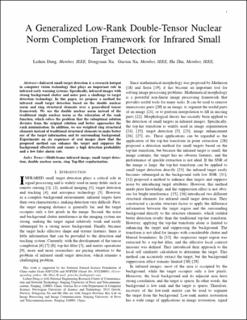| dc.contributor.author | Deng, Lizhen | |
| dc.contributor.author | Xu, Dongyuan | |
| dc.contributor.author | Xu, Guoxia | |
| dc.contributor.author | Zhu, Hu | |
| dc.date.accessioned | 2023-03-15T14:04:08Z | |
| dc.date.available | 2023-03-15T14:04:08Z | |
| dc.date.created | 2022-11-01T13:06:47Z | |
| dc.date.issued | 2022 | |
| dc.identifier.citation | IEEE Transactions on Aerospace and Electronic Systems. 2022, 58 (4), 3297-3312. | en_US |
| dc.identifier.issn | 0018-9251 | |
| dc.identifier.uri | https://hdl.handle.net/11250/3058528 | |
| dc.description.abstract | Infrared small target detection is a research hotspot in computer vision technology that plays an important role in infrared early warning systems. Specifically, infrared images with strong background clutter and noise pose a challenge to target detection technology. In this article, we propose a method for infrared small target detection based on the double nuclear norm and ring-structural elements over a generalized tensor framework. We use the double nuclear norm instead of the traditional single nuclear norm as the relaxation of the rank function, which solves the problem that the suboptimal solution deviates from the original solution and better approaches the rank minimization. In addition, we use weighted ring structural elements instead of traditional structural elements to make better use of the target information and its surrounding background. Experiments on six sequences of real images show that the proposed method can enhance the target and suppress the background effectively, and ensure a high detection probability and a low false alarm rate. | en_US |
| dc.language.iso | eng | en_US |
| dc.publisher | IEEE | en_US |
| dc.title | A Generalized Low-Rank Double-Tensor Nuclear Norm Completion Framework for Infrared Small Target Detection | en_US |
| dc.title.alternative | A Generalized Low-Rank Double-Tensor Nuclear Norm Completion Framework for Infrared Small Target Detection | en_US |
| dc.type | Peer reviewed | en_US |
| dc.type | Journal article | en_US |
| dc.description.version | acceptedVersion | en_US |
| dc.rights.holder | © IEEE. Personal use of this material is permitted. Permission from IEEE must be obtained for all other uses, in any current or future media, including reprinting/republishing this material for advertising or promotional purposes, creating new collective works, for resale or redistribution to servers or lists, or reuse of any copyrighted component of this work in other works. | en_US |
| dc.source.pagenumber | 3297-3312 | en_US |
| dc.source.volume | 58 | en_US |
| dc.source.journal | IEEE Transactions on Aerospace and Electronic Systems | en_US |
| dc.source.issue | 4 | en_US |
| dc.identifier.doi | 10.1109/TAES.2022.3147437 | |
| dc.identifier.cristin | 2067363 | |
| cristin.ispublished | true | |
| cristin.fulltext | postprint | |
| cristin.qualitycode | 1 | |
